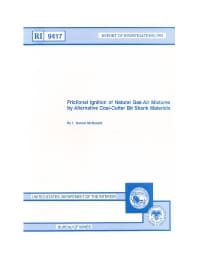Mining Publication: Frictional Ignition of Natural Gas-Air Mixtures by Alternative Coal-Cutter Bit Shank Materials
Original creation date: January 1992
Authors: LG McDonald
NIOSHTIC2 Number: 10011243
U.S. Department of the Interior, Bureau of Mines, Report of Investigations 9417, 1992:1-14
The U.S. Bureau of Mines tangentially impacted potential coal-cutter bit shank materials against sandstone to investigate the potential of the materials to ignite natural gas by a friction-generated hot streak. The shank material samples were mounted in a 24-in, 550-lb flywheel, which was rotated at surface speeds of 400 to 900 sfpm. The sandstone was advanced toward the rotating flywheel at feed rates of 1 mil per impact. The atmosphere mixture was 7 vol pct natural gas in air. Three grades of polycarbonate resin, an ultra-high-molecular weight polyethylene, and a zinc alloy (ZA27) were among the potential materials. None of these materials caused ignition of the methane at any of the three test speeds (400, 600, and 900 sfpm), but the above materials do not have sufficient strength to hold a carbide tip during coal cutting. Of the materials having sufficient strength to hold a carbide tip, three nickel-based alloys proved less likely to cause a natural gas ignition than did iron-based alloys such as 4340 (a commonly used shank material for coal cutters).

NIOSHTIC2 Number: 10011243
U.S. Department of the Interior, Bureau of Mines, Report of Investigations 9417, 1992:1-14